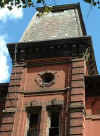 |
New York
Architecture Images-Brooklyn Bedford-Stuyvesant Excellence Charter School |
|
architect |
James W. Naughton restored with addition, Robert A. M. Stern 2005. |
|
location |
225 Patchen Ave. |
|
date |
late 1880s |
|
style |
Second Empire Baroque From Napoleon III's Second Empire: a mansarded central block over brick and brownstone: an admiring follower of Lefuel and Visconti's Louvre. |
|
construction |
red brick with brownstone trim |
|
type |
Education |
|
|
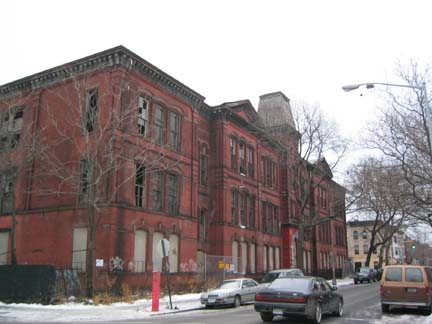 |
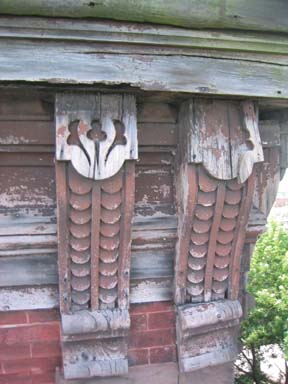 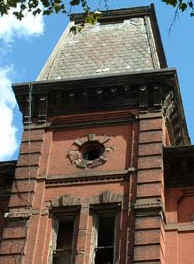 |
|
| The following images are copyright Robert A. M. Stern architects. | |
| Before and after. | |
.jpg) 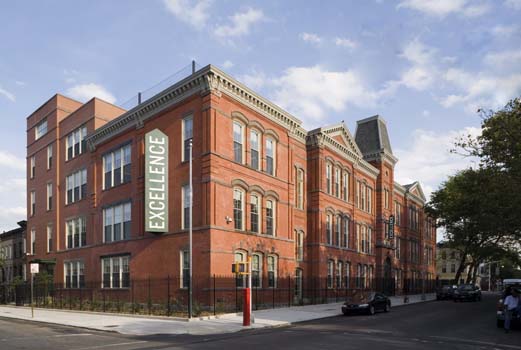 |
|
.jpg) .jpg) |
|
.jpg) .jpg) |
|
.jpg) .jpg) |
|
.jpg) .jpg) |
|
.jpg) .jpg) |
|
.jpg) |
|
|
The formerly abandoned Public School 70 is an important part of the urban
fabric of Bedford-Stuyvesant, and for too long, it stood as a dangerous
symbol of neglect in the neighborhood it once served. The quality of the
restoration of this once-derelict building and the sensitive new
addition, along with the return of this historic building to academic
use, is truly exemplary. James W. Naughton’s 1880 gauged red brick and brownstone school building was abandoned in the late 1970s after a major fire. Uncommon Schools, a non-for-profit organization known for developing urban college preparatory charter schools in the northeast chose the site for its academy in Brooklyn – Excellence Charter School – after an exhaustive search. “The lowest-risk strategy would have been to demolish the charred shell of the building,” said David Saltzman, Executive Director of the Robin Hood Foundation and a trustee of the Excellence Charter School. “It required the extraordinary vision of Robert A.M. Stern Architects to reincarnate this lost treasure as a new charter school.” Key Participants Uncommon Schools; Excellence Academies Foundation; Excellence Charter School of Bedford-Stuyvesant; New York City Department of Education; New York City School Construction Authority; Civic Builders; TLM Group; Robert Silman Associates; MGJ Associates, Inc.; Leonard Strandberg Associates; S. DiGiacomo & Son; Robert A.M. Stern Architects; Existing Conditions Surveys; Testwell Laboratories; JAM Consultants; Skyline Consultants; Pillori Associates; Cline Bettridge Bernstein Lighting Design; Fisher Dachs Associates; Shen Milsom & Wilke; Pentagram; Construction Specifications, Inc. |
|
|
The
Excellence Charter School-originally
Public School 70-was erected when Brooklyn was still a separate city
with an independent education system. All the school buildings built in
Brooklyn in the twenty years prior to incorporation with New York City
were designed by James W. Naughton, superintendent of buildings for the
Board of Education from 1879-98. The school was built in the French
Second Empire style, adopted in America when the building market in New
York began to recover from the economic effects of the Civil War.
Pavilions, which, emphasize verticality on the facade, and mansard
roofs, which elaborate the pavilions, were characteristic of the style. This building has an exact twin in Williamsburg, Brooklyn. (The Beth Jacob School) |
|
|
The Robin Hood Foundation's new Excellence Charter School in the
Bedford-Stuyvesant section of Brooklyn restores and adds to James W.
Naughton's 1880 gauged red brick and brownstone Public School 70,
reviving a significant neighborhood institution. Abandoned in 1990 after
a major fire, the building was exposed to the elements for approximately
thirteen years. The design retains and restores the building's
symmetrical pavilionated Patchen Street facade and portions of original
facade running east from Patchen Street along Macon and Mac Donough
Streets and the original classrooms behind them and a new wing was built
to the east. The brick facades have been repointed and cleaned;
brownstone trim and lintels have been patched with "Cathedral Stone"
in-situ patching or replaced entirely where structurally required using
cast stone to match the existing stonework. New aluminum windows were
installed to match the proportions, mullion divisions, muntins, and
brick mould profiles of the originals. An existing heavily damaged
wrought-iron fence separating the facade from the adjacent sidewalks was
replaced with a welded steel fence custom-designed to recall the
original. The existing roof structure was replaced with a new mansard
structure which matches the original and serves as a screen for
up-to-date rooftop mechanical equipment. The existing rolled asphalt
roof was replaced with Certainteed Grand Manor "Shangle" asphalt
shingles to give the appearance of slate (slate roofing exceeded the
budget). The new addition at the back of the building uses a similar
palette of materials but is rendered in a more stylistically neutral way
to give top billing to the historic school building.
Program elements essential to today's schools that were added to the existing school include eleven additional classrooms, a music classroom, a dance and fitness classroom, an art room, a science lab, a traditional library, shared office space for teachers on each floor, an ample cafeteria, a high school-sized gymnasium, and an auditorium to seat the entire school. An open-air rooftop playground was added atop these large program rooms. The building's interior is restrained with wide corridors appointed with lasting durable materials – doors of golden oak; linoleum floors; walls with a datum of warm white brick-shaped ceramic tile topped by a continuous band of tack wall for student work, and crowned by a running graphic text band with inspirational quotations about education. The historic classrooms are the highlight of the school and set the tone for the new classrooms, preserving the existing high ceilings and tall windows by carefully packing up-to-date mechanical infrastructure into corridor ceilings. Exposed sprinkler piping and suspended fluorescent strip fixtures set a modern loft-like tone softened by subtle checkerboard carpet-tile and low wood bookshelves that line the window walls concealing heating equipment. Classroom space extends into and enlivens corridors at each floor where book-nooks, where comfortable carpeted reading areas illuminated by sky-lit and windowed light-wells and cozy oversized lampshade fixtures created by converting the old building's non-code-compliant stairwells. A "club-like" library carved out of internal space is lined with built-in golden oak bookshelves and lit by borrowed natural light and a matrix of classic oversized shaded fixtures, providing a poised and scholarly gathering place for the school. Content © 2008 Robert A.M. Stern Architects LLP. All Rights Reserved. |
|
'Every Second Counts' at
This School
BY JULIA LEVY - Staff
Reporter of the Sun A yellow school bus pulls up
to the Excellence Charter School of Bedford-Stuyvesant at 7:22 a.m., and
a long line of little boys dressed in navy blue slacks, white shirts,
and navy blue ties jump to the curb. Standing curbside is Jabali
Sawicki, the new principal of Once inside, Mr. Sawicki
doesn't disappear into his office, which looks across the East River to
the He looks on as the children
do their "bright work" - quick projects that start their days - and eat
breakfast. He leads "morning meeting,"
greeting the school's 88 kindergartners and first-graders with a booming
"Good morning, Excellence Charter," as the director of community health
and fitness, Karenga Arifu, and a kindergarten teacher, Caleb Miller,
beat the djembe drums. He invites two boys who are
having trouble adapting to classroom rules into his office, and watches
them color cupcakes in a coloring book. "Between now and 2020 is a
very long road," Mr. Sawicki, 26, said, referring to the year when the
first-graders will graduate from college. "We have a long way to go and
every second counts." Mr. Sawicki grew up in In seventh grade, she sent
him to Stuart Hall for Boys, a single-sex Catholic school in "My friends from my
neighborhood weren't into education, weren't into working hard," he
said, sitting in his new office on Friday morning. "There was definitely
a push to be cool, to be tough, to over-emphasize sports, to be the
class clown...to act as if I was too cool to learn." He was torn between the
expectations of his friends and society and those of his demanding
mother. Sometime in the eighth grade,
he said, his mother won out when he realized he had fun at school and
that he could put his natural competitiveness toward earning the best
grades in literature class. After middle school, he went onto one of Mr. Sawicki majored in
philosophy and biology and was planning on making a career of biology
until a fellowship fell through and one of his mentors sent him an
e-mail about a science teacher position at the He spent three years there.
Like most charter schools, Roxbury was trying to close the
much-talked-about achievement gap that separates poor, inner-city, black
and Latino children from wealthier white and Asian children. But even as he and his
colleagues were making some ground on closing that gap, Mr. Sawicki
noticed that there was another persistent achievement gap that wasn't
being talked about and wasn't being closed - between boys and girls. He
started thinking of how it could be narrowed. Mr. Sawicki said he realized
that boys in inner-city communities like the one he came from in As a result, he said, young
boys grow up feeling "restricted" about what they can become. When he got a call from that
same mentor about starting an all-boys charter school in The community where
Excellence opened two weeks ago has some of the same problems as the one
he came from. In Bedford-Stuyvesant's In the district, 37% of
fourth-grade girls passed He said creating an
academics-focused, all-boys school in the neighborhood would "create an
environment where the coolest thing young boys can be is smart." He said
he hopes to target some of their specific needs to help them beat the
achievement gaps and eventually get into college. At Excellence, the school
year is 192 days, 12 days longer than the The days themselves are also
longer, starting at 7:30 a.m. and ending at 4 p.m. As the first students
get older and move into higher grades and the school expands to its full
size - kindergarten through eighth grade - the school day will get even
longer, with sports tacked onto the end of the day. In the course of the school
day, as it exists now, each child has three hours of literacy
instruction, 90 minutes of math, and 45 minutes combined of social
studies and science. There is regular testing to
find out what the students have learned and to target problem areas. He said that since the school
is so young, there's no data yet. But he said it's already clear that
there is a range of ability. Some students don't know the alphabet while
others are reading on a third- or fourth-grade level. Regardless of data, parents
who send their sons to Excellence seem ecstatic that their numbers were
picked in the school's lottery, and they're convinced that the school
will do wonders for their children. There's a waiting list of 85 boys. Toi Washington-Simon drives
45 minutes from Felisha Krause, who stood
beside Ms. Washington-Simon outside the school after dropping off her
6-yearold, Jorden Plaines, added she could tell what her son is learning
because she received a breakdown of his day. "The focus here is definitely
math, English, history," she said. Both said the "energy level"
of the principal is also a bonus. Ms. Krause marveled at how he
met Jorden once and remembered his name. Ms. Washington-Simon said she
knows Mr. Sawicki is involved every day because Seven comes home talking
about what his principal said and did. "He is always full of
energy," Ms. Krause said. "He brings the focus back to where it needs to
be, on education." |
|
| http://www.excellencecharter.org/ | |